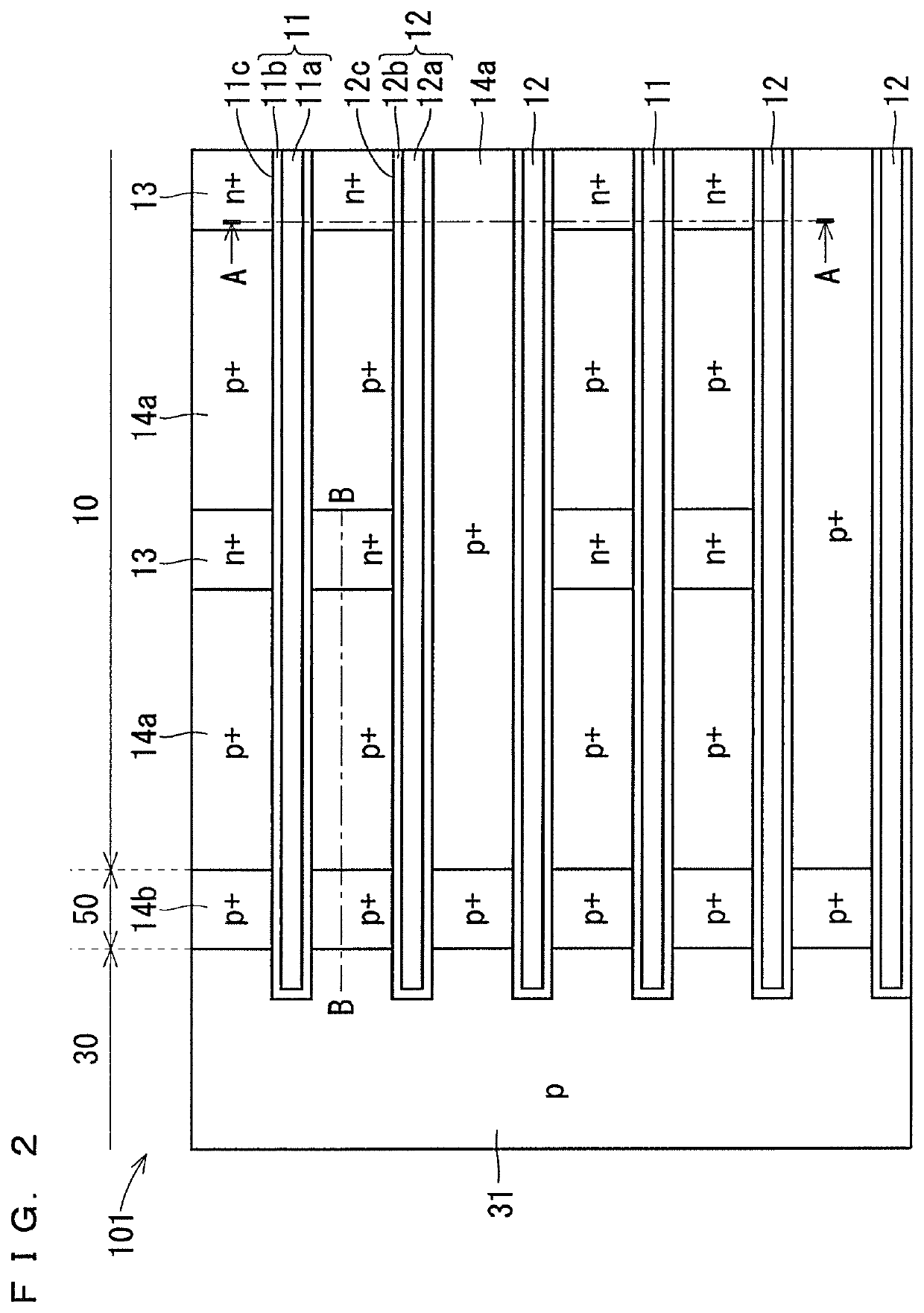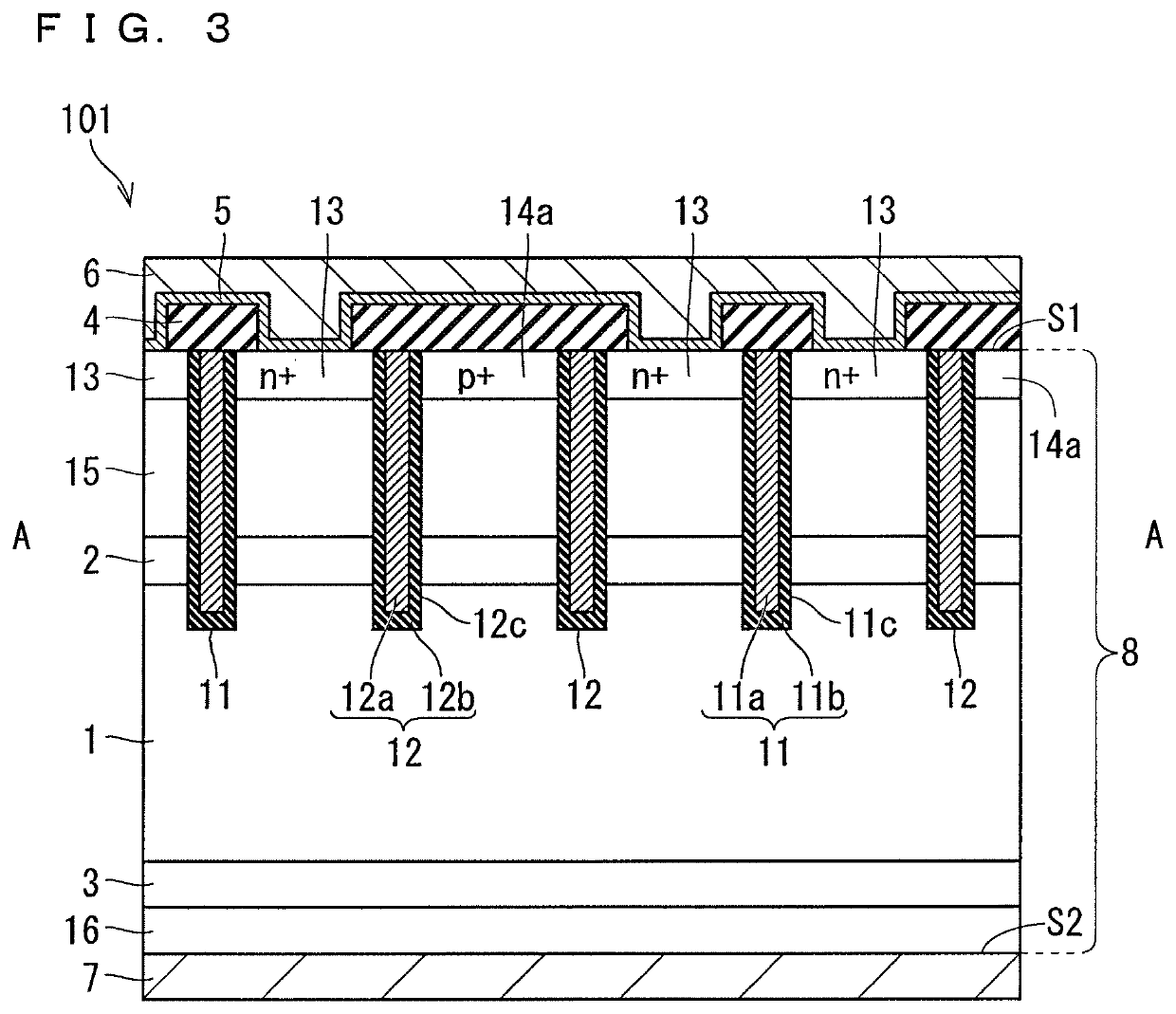Method of manufacturing semiconductor device
- Summary
- Abstract
- Description
- Claims
- Application Information
AI Technical Summary
Benefits of technology
Problems solved by technology
Method used
Image
Examples
embodiment 1
A. Embodiment 1
[0035]
[0036]FIG. 1 is a plan view of an IGBT 101 being a semiconductor device of Embodiment 1. FIG. 2 is an enlarged plan view of a region P illustrated in FIG. 1 of the IGBT 101. FIG. 3 is a cross-sectional view of the IGBT 101 along the line A-A of FIG. 2. FIG. 4 is a cross-sectional view of the IGBT 101 along the line B-B of FIG. 2.
[0037]First, the planar structure of the IGBT 101 will be described. As illustrated in FIG. 1, the IGBT 101 includes an active region 10, a boundary region 50, and an edge region 30. That is, the IGBT 101 is demarcated into the active region 10, the boundary region 50, and the edge region 30 in plan view. The boundary region 50 surrounds the active region 10 in plan view. The edge region 30 surrounds the boundary region 50 in plan view. A pad region 40 including pads 41 may be provided between the boundary region 50 and the edge region 30 in plan view.
[0038]Next, with reference to FIG. 4, the cross-sectional structure of the IGBT 101 com...
embodiment 2
B. Embodiment 2
[0069]
[0070]FIG. 11 is a cross-sectional view of an IGBT 102 of Embodiment 2 along the line B-B of FIG. 2. Other cross-sectional configurations and planar configurations of the IGBT 102 are the same as those of the IGBT 101 of Embodiment 1.
[0071]In the IGBT 102, the width Wi of the boundary region 50 is greater than the depth De of the emitter layer 13. Further, in the IGBT 102, the depth Dh of the first contact layer 14a and the second contact layer 14b is deeper than the depth De of the emitter layer 13.
[0072]
[0073]In the IGBT 102 of Embodiment 2, the width Wi of the boundary region 50 is greater than the depth De of the emitter layer 13. Therefore, the n-type impurity ions implanted to form the emitter layer 13 do not reach the edge region 30 even if the semiconductor substrate 8 is diffused in the lateral direction. As a result, the formation of the parasitic emitter layer on the surface of the edge region 30 is suppressed, and improvement in the fracture resistan...
embodiment 3
C. Embodiment 3
[0075]
[0076]FIG. 13 is an enlarged plan view of the IGBT 102 of Embodiment 2 in the region P of FIG. 1. FIG. 14 is a cross-sectional view of the IGBT 103 along the line C-C of FIG. 13. As illustrated in FIGS. 13 and 14, the IGBT 103 has a p-type third contact layer 14c interposed between the first contact layers 14a on both sides in the active region 10 and is otherwise similar to the IGBT 101.
[0077]The third contact layer 14c does not contain n-type impurities having a concentration equal to or higher than the n-type impurity concentration of the drift layer 1. The net impurity concentration of the third contact layer 14c is higher than the net impurity concentration of the first contact layer 14a. In FIG. 14, although the base layer 15 and the carrier storage layer 2 immediately below the third contact layer 14c are locally shallow, the base layer 15 and the carrier storage layer 2 may be uniformly formed as in the IGBT 101 of Embodiment 1.
[0078]The base layer 15 an...
PUM
 Login to View More
Login to View More Abstract
Description
Claims
Application Information
 Login to View More
Login to View More - R&D
- Intellectual Property
- Life Sciences
- Materials
- Tech Scout
- Unparalleled Data Quality
- Higher Quality Content
- 60% Fewer Hallucinations
Browse by: Latest US Patents, China's latest patents, Technical Efficacy Thesaurus, Application Domain, Technology Topic, Popular Technical Reports.
© 2025 PatSnap. All rights reserved.Legal|Privacy policy|Modern Slavery Act Transparency Statement|Sitemap|About US| Contact US: help@patsnap.com



